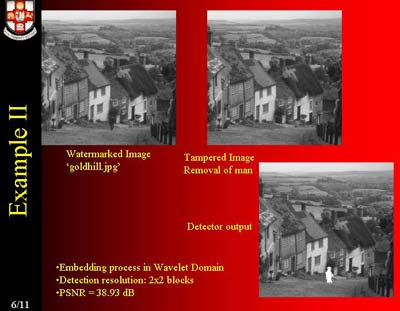Hi-tech ‘watermark’ will expose digital images that have been tampered with

Digital images that have been tampered with could now be spotted – thanks to a digital ‘watermark’ developed by UK scientists
Digital images such as CCTV footage are increasingly being used as evidence in high profile court cases. However, it is easy to tamper with an image and very difficult to tell if any manipulation has taken place.
Researchers have created a digital version of a watermark to tackle this problem and validate digital evidence. The team is led by Professor Dave Bull at the University of Bristol and funded by the Swindon based Engineering and Physical Sciences Research Council.
The watermark will appear on the images – either still or video- and track any changes made to the original version.
Professor Bull said: “With a hi-tech problem, we needed a hi-tech solution, but drew our inspiration from the humble paper watermarks first created in the 18th century”.
Professor Bull’s team’s version of the centuries old ‘watermark’ works by creating an electronic seal around the image in its original state. The watermark is applied automatically at the point when the image is taken by incorporating appropriate software into the camera. Encoded information within the watermark will show if it is subsequently tampered with.
“The idea is that if the image file is passed through a special statistical detector it will be able to read the digital watermark and detect if the image has been attacked. It will also show how the image has been amended – for example the hands on a clock might have been changed to show a different time, or a face might have been obscured,” says Professor Bull.
Professor Bull hopes his team’s research will be adopted by digital film and camera manufacturers and applied as part of an industry-wide security standard.
The watermark uses patent-pending technology, which is based on the use of mathematical algorithms
Media Contact
All latest news from the category: Information Technology
Here you can find a summary of innovations in the fields of information and data processing and up-to-date developments on IT equipment and hardware.
This area covers topics such as IT services, IT architectures, IT management and telecommunications.
Newest articles

A universal framework for spatial biology
SpatialData is a freely accessible tool to unify and integrate data from different omics technologies accounting for spatial information, which can provide holistic insights into health and disease. Biological processes…

How complex biological processes arise
A $20 million grant from the U.S. National Science Foundation (NSF) will support the establishment and operation of the National Synthesis Center for Emergence in the Molecular and Cellular Sciences (NCEMS) at…

Airborne single-photon lidar system achieves high-resolution 3D imaging
Compact, low-power system opens doors for photon-efficient drone and satellite-based environmental monitoring and mapping. Researchers have developed a compact and lightweight single-photon airborne lidar system that can acquire high-resolution 3D…





















